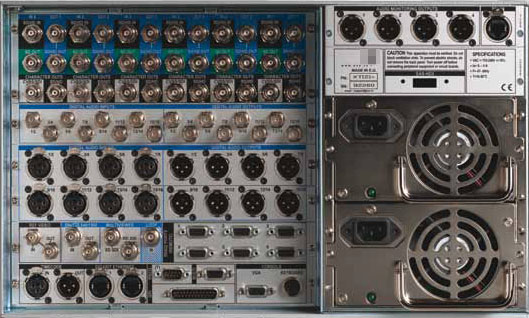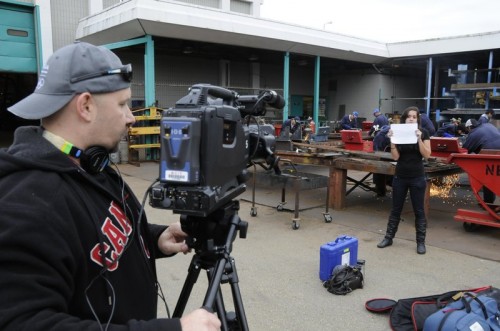This week has been the first time we’ve taken our new first-year students out to work with their equipment around the BCIT Campus in a “production capacity”.
Students have been out practising the camera, audio, and composition skills they’ve learned over the last few weeks to produce short segments about some of the trades and technical students at BCIT. We’re looking for proper technical control of the camera (focus, aperture, white balance, audio levels), proper use of microphones (which mic to use, where to place it for optimum pickup), and how to compose shots to make it interesting for viewers.
After shooting, we head back to the broadcast centre to spend the afternoon in the edit suite with Final Cut Pro, putting all of the footage together so we can do some critiquing in class and learn about what worked and what didn’t.
A fairly busy day, but great hands-on experience!
A new piece of live television production equipment just arrived at BCIT Broadcast today…

It’s probably the single most popular tool for covering live sporting events, and we will be training our students on it soon…
What could it be…?
By now you’ve probably had a chance to see some of the examples of the iPhone 4’s HD video capabilities. The HD video quality is very impressive (especially under controlled conditions), but what about the audio?
Using the built-in microphone isn’t an option for high-quality sound capture.
Did you know that you can use an inexpensive adaptor to feed microphone audio directly into the phone via the headphone jack?
Jeff Geerling has a great article up on his website that details exactly how to go about making everything work by creating a portable kit that can be used for capturing high-quality video with decent sound.
There’s another excellent on his site that focuses specifically on audio recording.
Having shot a number of videos on the iPhone 4 during my recent trip to Shanghai, the other major factor is that you will require a tripod or stabilizer. The phone itself is just too small to hold perfectly steady when you’re trying to shoot something.
Many people are probably familiar with open-source software, but when was the first time you’ve seen an open-source HD Cinema camera?
The “Apertus” is being developed by a team of international enthusiasts to give total control over inexpensive HD imaging hardware, allowing filmmakers to potentially develop their own alternatives to commercial offerings from Sony, Panasonic, Red, etc.
While it’s definitely still a work-in-progress, this sort of project would’ve been cost-prohibitive a few years ago. Now, the cost of the camera hardware (minus lens and audio) is only around $3,000 – and the software is free!
While it might not be as user-friendly or have a workflow as efficient as a camera from one of the major manufacturers, it does prove how quickly technology is changing, and how quickly people are exploring new options as they become available.
Check out a sample movie (click through to Vimeo for the HD version)
Discovery HD Canada (now Discovery World HD) is sponsoring an environmental short film competition.
From the press release:
Feel there’s an environmental story yet to be told? This is your chance to tell it!
The Film Snacks Competition is a platform for the best of tomorrow’s film-making talent, featuring compelling short-films that build on environmental themes. You could have your film screened on the BIG screen, TV, and online!
To enter, you must simply upload your short film (2 minutes or less) to the designated page. Your submission must be based on an environmental theme.
Judges will be basing their decision on production quality (video and audio), creativity and entertainment value and choice of topic. The contest opens August 18, 2010, 12:01 a.m. ET and runs through to September 17, 2010, 4 p.m. ET.
The grand prize includes $2,000 cash, a trip for two to Toronto, two tickets to the Planet in Focus Gala Event in Toronto on October 15, 2010, and the rare opportunity to showcase YOUR winning film at the Event.
The winning film will also air on Discovery World HD, and will be featured on DiscoveryWorldHD.ca.
Check out the webpage for full details!







